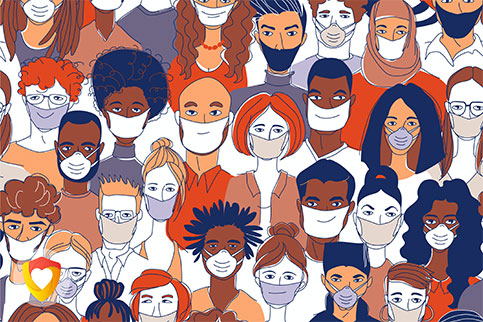COVID-19 has changed our world overnight. It’s hard to believe that less than six weeks ago, I was still driving my son to school, eating in restaurants, flying to work meetings, and seeing patients unmasked in the emergency department (ED).
Now, with most of the country locked down and the pandemic racing toward its peak, the question looms: When, if ever, will things get back to “normal?” And what exactly will that look like?
No one knows for sure. News reports are full of speculation about herd immunity, second waves, antibody tests, and more. But after practicing emergency medicine in the hard-hit Seattle area and consulting with clinicians around the world, I’ve formed a tentative picture of our future. Here are a few factors that I believe could either set us free—or prolong our quarantine.
Social Distancing
First the good news: Social distancing works. Asian countries like Singapore, Hong Kong, Taiwan, and South Korea have used stringent quarantine orders and contact tracing to hold infection rates down. (They’ve also seen resurgences when they loosened these restrictions while COVID-19 was spreading elsewhere.)
The United States was late to embrace social distancing and suffered as a result. However, the first communities to issue shelter-in-place orders are now experiencing a leveling off in new cases, hospitalizations, and deaths.
While this is great news, I worry that social distancing will be a victim of its own success. As deaths and hospitalizations drop, social and political pressure will mount to reopen the country.
We need to open up, as a sinking economy has its own negative impacts on public health. But I fear that if we let up on the gas too soon, we’ll see flare-ups of disease before we’re able to contain them effectively. So what needs to happen before we return en masse to public life?
Thoughts on Next Steps
Based on my experience and my conversations with experts in the field, here’s what I believe we need to achieve before loosening social distancing requirements.
First, health systems need to be prepared to manage local resurgences. This means:
- Robust capacity and procedures to safely manage all respiratory patients.
- Access to timely and accurate testing to identify/rule out COVID-19 cases.
- Sufficient inventory of personal protective equipment (PPE) for providers to safely work and control infection. Over the long term, this will require a larger quantity of PPE than before the pandemic.
If a local outbreak occurs, health systems must be ready to return to lockdown status on short notice. This could mean limiting visitors, canceling elective surgeries, and shifting outpatient services to telehealth. While financially painful, these steps will be necessary in some systems to save staff and patient lives.
Second, communities must have enough testing capacity to monitor our population for flare-ups. Research suggests that COVID-19 was circulating for weeks in New York and Seattle before the first cases were diagnosed. To prevent similar outbreaks in the future, we need a surveillance system in place. This will require timely, accurate, and widely available testing—a scenario we’re making progress toward but haven’t yet achieved.
Third, we need better measures to protect our most vulnerable. Individuals in nursing homes, group living situations, homeless shelters, and jails need to be equipped for long-term containment with assertive isolation, PPE, and testing strategies. These environments incubate the virus prior to it exploding out into the community, as we learned the hard way in Seattle.
Finally, lifting the quarantine demands processes to quickly contain—not just mitigate—flare-ups. Our best tool to accomplish this may be through contact tracing. This means that when a patient tests positive, public health authorities track down and warn others the person may have infected. Some Asian countries credit contact tracing (accomplished both through a combination of cellular apps and old-fashioned leg work) for their relatively low death rates.
Could contact tracing work in the United States? We’re about to find out. Tech giants Google and Apple have teamed up to create a tracing tool for public health departments. They also plan to release opt-in tools that will help individuals spot potential exposures.
I’m not sure that Americans will embrace contact tracing the same way people in Asian countries have. My guess is that our individualistic culture could find these measures invasive. On the other hand, people may be more cooperative if tracing helps us get back to work and school sooner.
Could Immunity Passports Help?
Some countries, including Germany, the United Kingdom, and Italy, have floated the idea of issuing “immunity passports” to patients who have survived to COVID-19. This would allow certain people to return to work and school. “Immune” healthcare providers could treat respiratory patients with fewer precautions while those who were still vulnerable could be assigned to lower-risk duties.
While the idea of immunity passports is interesting, I just don’t think they’re a feasible solution—at least in the near term. First, as this MIT Technology Review article details, we don’t yet have an accurate test for COVID-19 antibodies. Tests that produce false positives could send people who are vulnerable to infection into harm’s way and spark new outbreaks.
What’s more, the presence of COVID-19 antibodies doesn’t necessarily confer permanent immunity. In fact, few infections behave this way (chickenpox, for example). More commonly, antibodies provide short-term immunity that fades over a period of months to years. And in some cases, antibodies provide only partial immunity or none at all.
I also worry that immunity passports would have social consequences. Workers whose paychecks depend on developing antibodies might feel perverse pressure to get infected to return to work. People in public-facing and service industry jobs—who tend to earn less and have less access to healthcare—would be most impacted.
Staying the Course
As workers, parents, students, entrepreneurs, healthcare providers—and humans of planet Earth—I think we all agree that social distancing can’t end soon enough. This longing for freedom and normalcy is completely understandable. At the same time, I worry that lifting restrictions too soon could spark a resurgence of the disease. Haste would only prolong our economic standstill and further strain our healthcare resources.
It’s said that when public health is doing great work, nothing happens. If we continue social distancing while awaiting widespread testing and containment, we’ll no doubt save lives. The better we do our part, the less urgent the crisis will seem. But I want us to keep our eye on the ball and realize that our sacrifices are never in vain. If only we could know how many lives one person staying home could save.
COVID-19 has forced us to come together as a society, paradoxically through social distancing. We’ve already won many battles against the virus. Our challenge now is to stay committed, resolute, and hopeful—for as long as containment takes.
As I write, the United States is bracing for an unprecedented surge in COVID-19 deaths. U.S. Surgeon General Jerome Adams warns that the coming week will be our “Pearl Harbor moment.” Only this time, the pain and shock will have a direct impact in communities across the country.
Recent modeling by the University of Washington’s Institute for Health Metrics and Evaluations (IHME) has predicted that even with mitigation measures like social distancing in place, 100,000 to 240,000 Americans could die of COVID-19. Some scientists believe this is an overestimate. But most experts agree that we can expect to see a surge in COVID-19 deaths in coming weeks.
While this news is sobering, there’s also reason for hope.
A surprising reversal
A month ago, Washington state was the epicenter of the COVID-19 pandemic in the United States. We were home to the first U.S. case (Jan. 20) and the first death on American soil (Feb. 29). Cases have been rising ever since. Healthcare providers have been conserving personal protective equipment (PPE) and supplies to prepare for the inevitable disease peak, which IHME has forecasted for April 19.
However, the expected surge in cases hasn’t materialized. Two weeks ago (the week of March 23), hospitalizations due to COVID-19-like illness declined by 20% in Washington state. This ends a monthlong rise in admissions. These numbers suggest we’ve successfully flattened the curve. The models agree; IHME is now predicting 20–30% fewer hospitalizations at peak than just a week ago.
I’m seeing evidence of this shift at my own hospital. A few weeks ago, our ICU had so many patients on ventilators that they spilled into the step-down unit. But two to three weeks after social distancing measures went into effect, this volume began to contract. Today, we are managing all ventilated patients within the ICU. And the numbers continue to fall.
Quarantine works
What’s making the difference? First, it appears that our efforts at social distancing (which began early in Washington) haven’t been in vain. When the Institute for Disease Modeling (IDM) used Facebook data to track mobility, they found that Seattleites appeared to be avoiding commercial areas. In late February, the IDM model suggested that one infected person spread the disease to 2.7 people. By March 18, thanks to social distancing, that number had dropped by half to roughly 1.4.
A word of caution
While hopeful, Washington’s experience underscores the importance of continuing infection control precautions in both community and clinical settings. If society takes its foot off the gas too soon, we could see a disease resurgence. This especially holds true for healthcare providers on the front lines of the pandemic.
Providers often feel uniquely vulnerable to infection. However, we know that PPE, when worn and removed properly, is very effective against COVID-19. There are no chinks in our “armor.” We just need to wear it all the time—ideally universally masked through our entire shifts. This means protecting ourselves in nonclinical areas like break rooms and also while interacting with fellow providers and staff.
Another way we can protect ourselves is by practicing meticulous hand hygiene. In addition to PPE, hand-washing is our best weapon against a virus that can live on surfaces for hours to days. Yet research suggests that hospital-based providers are about 50 to 60% compliant with hand-washing guidelines. (By contrast, commuters using New York train station bathrooms wash their hands 80% of the time.) One-hundred percent compliance would improve safety, not just of patients but also of providers and their families.
Hope . . . and keep your foot on the gas
Washington state’s experience should give healthcare providers across the country reason for hope. We are seeing that behavioral interventions like social distancing work, and that predictive modeling does not write our destinies in stone.
At the same time, these gains were likely due to early and stringent precautions, including a government lockdown, appropriate use of PPE, and early implementation of screening and telehealth procedures at hospitals.
As we hope, we must continue to follow strict infection control procedures—perhaps for several more months. While wearing a mask and eye protection and frequently washing hands through an entire shift is burdensome, doing so consistently is the surest way to avoid infection. And while our new normal of shuttered restaurants, closed parks, and shut-down schools is challenging, we need to keep pushing forward to flatten the curve and return us all to normalcy faster.























